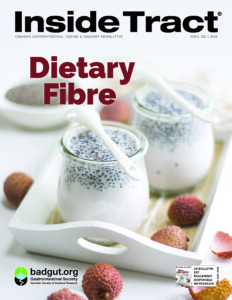
Physical Activity and Digestive Health:
It’s Complicated!
Exercise for the gastrointestinal (GI) patient can be a complex issue, but implementing the right level and combination of physical activity should be beneficial for most.
Some forms of physical activity can have significant negative effects on GI conditions, whereas others have a known protective effect against specific diseases and disorders. Intense exercise, for example, can have a temporary negative effect on the GI tract, including nausea, heartburn, diarrhea, and gastrointestinal bleeding. Runners are especially susceptible to these negative effects, but they can minimize their risks with appropriate fluid intake and by limiting use of non-steroidal anti-inflammatory drugs (NSAIDs).1 However, if you have inflammatory bowel disease, you should not use NSAIDs at all. If you live with a chronic GI condition, then running a marathon might not be the best option for you. Thankfully, there are plenty of other exercise choices. Walking, jogging, biking, swimming, rowing, lifting weights, and participating in organized sports are all great ways to get a little physical activity. This article will outline what the latest research tells us about the relationships between physical activity and some GI conditions. Please consult with your physician before making any significant changes to your personal exercise regimen.
IBS
Irritable bowel syndrome (IBS) is a chronic functional gastrointestinal disorder that has no detectable organic trigger and symptoms that include abdominal pain, bloating, and constipation and/or diarrhea. It affects up to 20% of Canadians. Often debilitating, IBS has no known cause or cure. There are, however, several treatments, including diet modifications and medications, which might reduce symptom severity.
Research has shown that exercise can help with occasional gas or bloating in individuals without IBS, but scientists in Sweden recently collaborated on a new study investigating whether physical activity is a valid treatment specifically for IBS.2 The study included 102 IBS patients who researchers divided randomly into a physical activity group and a control group. The physical activity group was required to exercise for 20-60 minutes at a moderate-to-vigorous level, 3-5 times a week, for 12 weeks. The control group subjects simply maintained their current lifestyles. The results found that 43% of patients in the physical activity group had a significant decrease in symptom severity, compared with 26% of patients in the control group. Only 8% of patients in the physical activity group had an increase in symptom severity, compared to 23% in the control group. Similar to previous studies, the physical activity group also demonstrated significant improvement in sleep, energy level, physical functioning, and social interaction, but not in mental health, diet, or sexual relations. In addition to demonstrating that physical activity can be an effective way for some IBS patients to reduce the severity of their symptoms, this study suggested that a lack of physical activity may actually lead to worsening symptoms.
In another small study investigating bloating, researchers found that mild activity increased gas passage and helped to prevent gas retention for IBS patients. The study authors cautioned that they did not examine more vigorous forms of exercise, which may have different effects on bloating.3
Constipation (Not IBS)
There is some research in support of low-intensity physical activity as a treatment for some types of constipation, making it ideal for seniors or others with physical challenges, for which vigorous exercise might be contraindicated.1 Chronic constipation affects 15-30% of Canadians, and is commonly found in young children and the elderly, occurring more frequently in females than in males.
One recent study examined whether a lack of physical exercise increased an individual’s risk for constipation.4 The researchers asked about a thousand professionals to answer questions about constipation, physical activity, and quality of life. The results showed no correlation between physical activity and risk for constipation, but they did show that physical activity correlated with an increase in quality of life scores. Since constipation is associated with a lowered quality of life, exercise may be beneficial even if it does not directly improve constipation symptoms.
GERD
Gastroesophageal reflux disease (GERD) occurs when the upper portion of the digestive tract does not function properly, causing stomach contents to flow back up into the muscular tube (esophagus) linking the mouth to the stomach. In normal digestion, a specialized ring of muscle at the bottom of the esophagus called the lower esophageal sphincter (LES) opens to allow food to pass into the stomach, and then quickly closes to prevent backflow into the esophagus. The LES can malfunction, allowing contents from the stomach, including food and digestive juices such as hydrochloric acid, to push up into the esophagus. In GERD, this backflow occurs repeatedly. Approximately 13-29% of Canadians experience recurring GERD symptoms.
Earlier studies have suggested that strenuous exercise can trigger GERD symptoms, such as heartburn, the sensation of food flowing up into the mouth, and a bitter or sour taste, but more recent studies have shown that vigorous exercise (though not moderate or mild exercise) can actually help prevent refluxing episodes.1
Another recent study showed that GERD symptoms associated with physical activity are more likely to occur shortly after a meal, suggesting that timing of exercise is important.5 The uncomfortable symptoms of reflux are more likely to be felt if the acidic material reaches the lower end of the esophagus, which, in turn, is more likely to occur if the stomach is very full (e.g., after a large meal). Since physical exercise can trigger a reflux episode, that episode is more likely to be most severe if it occurs right after a meal. The researchers suggest that it is better for GERD patients to delay physical activity until the digestive system has had some time to process ingested food.
Ulcer Disease
Peptic ulcers, which usually result from infection with bacteria called Helicobacter pylori (H. pylori), are sores or breaks in the lining of any part within the digestive tract that contains concentrated gastric juice. Previous research has linked physically demanding jobs with ulcer disease, but newer studies have shown no correlation between physical activity and risk of peptic ulcers.1 In fact, evidence reveals that moderate leisure-time physical activity can have a protective effect on the gastrointestinal lining.
IBD
A number of studies have tested whether physical activity has any protective effect against inflammatory bowel disease (IBD), which includes Crohn’s disease, ulcerative colitis, and ulcerative proctitis, but the results have been inconclusive.1
While exercise is not harmful to patients who have IBD in remission or with only mild disease activity, individuals who have active or severe disease can find exercise very challenging, if not impossible. Researchers recommend low- to moderate-intensity physical activity for IBD patients whose disease is mild or in remission, if not for direct improvement of their IBD, then for other proven benefits such as increased muscle strength, reduced stress, improved quality of life, and overall better health.
Diverticular Disease
Diverticular disease, which affects 50% of those older than 60 years of age, is the presence of small sac-like out-pouchings (diverticula) of the colon lining, which balloon through the outer colon wall. Many individuals have no symptoms and do not realize they have this disease until they experience a flare-up (diverticulitis), in which the diverticula become inflamed and/or infected and cause pain, fever, and/or other symptoms.
Diverticular disease is more prevalent among those who have sedentary occupations (e.g., office setting).1 In addition, vigorous exercise can significantly reduce an individual’s risk for the disease. In a recently-published 18-year study of approximately 50,000 US males aged 40-75 years, researchers found a lower incidence of diverticular disease complications in those who were physically active.6 In addition, regular running correlated with a significantly decreased risk of diverticulitis and diverticular bleeding. Other types of vigorous activity, such as biking, swimming, and tennis, showed only a slight decrease in risk of complications, but light and moderate exercise appeared to have no direct effect on the participants’ risk of complications.
The researchers think the up and down motion of running and jogging may decrease colonic pressure, cause food to move more quickly through the digestive tract, and stimulate defecation, all of which are associated with a lower risk of diverticular complications. Conversely, the study found that obese, inactive men were at an especially high risk for complications from diverticular disease.
Gallstones
Gallstones, which develop in the gall bladder, are solidified deposits of cholesterol or the yellow pigment in bile that the liver produces (bilirubin). These stones are the leading cause of acute pancreatitis, a condition that usually requires hospitalization. The right level of physical activity can help avoid gallstones.1 Researchers believe this is due to a number of related health benefits of physical activity, such as reduced plasma triglyceride and insulin levels, increased levels of good cholesterol (HDL-C), and prevention of bile stasis (during which bile cannot move from the liver to the duodenum) by increasing muscle movement. The current research suggests that finding the right level of physical activity to gain a benefit is complicated, but any level of physical activity is better than no exercise when it comes to preventing gallstones.
Liver Disease
Obesity and insulin-resistance are key risk factors for non-alcoholic fatty liver disease (NAFLD). It affects more than 20-30% of Canadian adults and is becoming increasingly common. Exercise is a standard recommendation for individuals with the disease. Numerous studies have shown that weight loss resulting from physical activity leads to a reduction of liver fat and/or a reduction in harmful liver aminotransferase concentrations.1
A recent retrospective study attempted to analyse the relationship between physical activity and risk of severe NAFLD-related conditions such as non-alcoholic steatohaheptatiis (NASH) and advanced fibrosis.7 The study revealed that physical intensity might have a greater role over duration or total volume of activity in exercise’s effect on NAFLD. The researchers, who studied 813 middle-aged adults with NAFLD, found that only very vigorous physical activity, such as running on a treadmill, had an effect on the severity of NAFLD.
GI Cancers
Colorectal cancer (CRC) is the second leading cause of cancer mortality in Canada, after lung cancer. An estimated 6% of Canadians will develop CRC, half of whom will be asymptomatic until advanced stages of the disease. There is strong evidence that physical activity can decrease an individual’s risk of developing gastrointestinal cancers, especially colon cancer.1 As well, physical activity can help with other health issues that are known risk factors for colon cancer, including obesity, insulin resistance, impaired immune function, and high triglyceride levels.
One study of nearly 500,000 US men and women over an eight-year period found that physical activity may also have a preventative effect against upper gastrointestinal tract adenocarcinomas, which are often associated with GERD and Barrett’s esophagus.8 However, the researchers found no such protective effect against squamous cell GI carcinoma, which is usually associated with tobacco and alcohol use.
Conclusion
Talk to your physician to determine the best type and level of exercise for you. When introducing or increasing physical activity, it helps to set a schedule, and then to stick to it. Be creative and think about encouraging your family to exercise with you. Whatever your condition, there is likely some form of physical activity that could improve your health and potentially relieve some GI symptoms.
4 Key Points about Exercise and GI Conditions1
- Vigorous exercise may trigger gastrointestinal symptoms, which are mostly transient and do not have long-term consequences.
- There is convincing evidence that physical activity reduces the risk of colon cancer.
- Evidence for the positive effects of physical activity is less convincing for gastric and pancreatic cancers, gastroesophageal reflux disease, ulcer disease, non-alcoholic fatty liver disease, gallstone disease, diverticular disease, irritable bowel syndrome, and constipation.
- Mild physical activity may help inflammatory bowel disease, although evidence is not conclusive.















